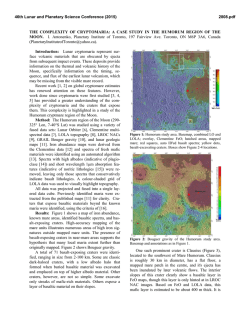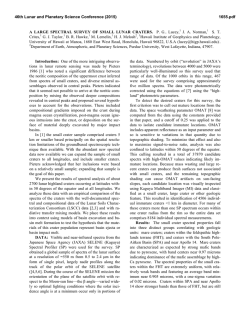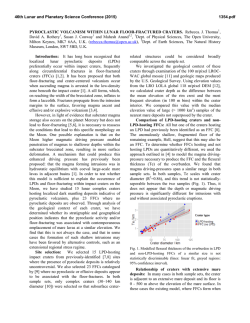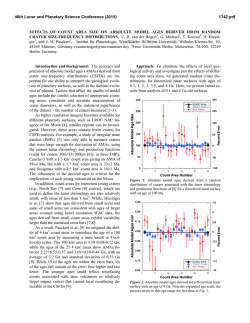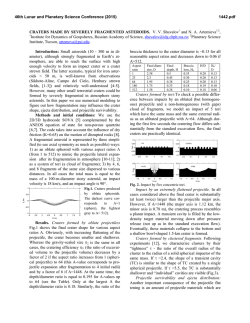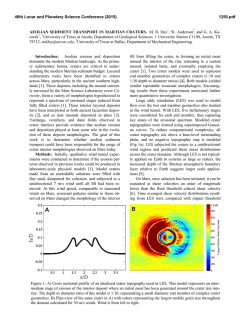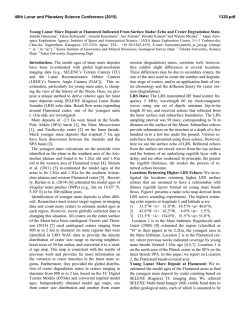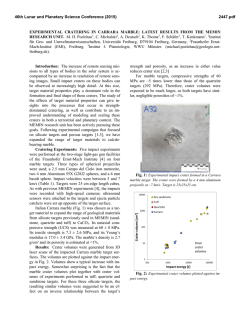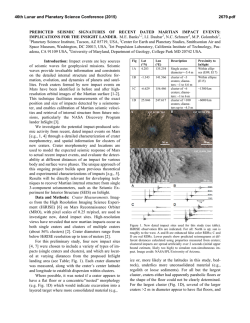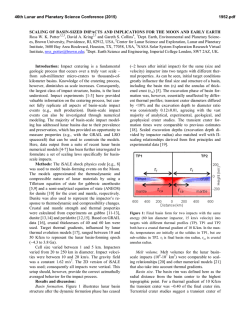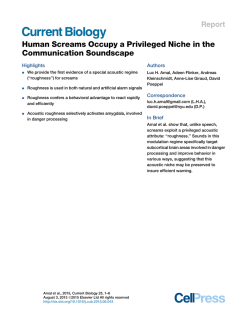
COPERNICAN-AGE CRATERS AND LOLA DECAMETER
46th Lunar and Planetary Science Conference (2015) 2218.pdf COPERNICAN-AGE CRATERS AND LOLA DECAMETER-SCALE ROUGHNESS. G. A. Neumann1, P.A. Glaeser2, H. Hiesinger3, Maria T. Zuber4, David E. Smith4,1NASA Goddard Space Flight Center, Greenbelt, MD 20771, USA ([email protected]); 2Dept. Geodesy and Geoinformation Science, Technical UniversityBerlin, Strasse des 17.Juni 152, 10623 Berlin, Germany ([email protected]); 3Institut für Planetologie, Westfälische Wilhelms-Universität Münster, Munster, Germany, 4Department of Earth, Atmospheric and Planetary Sciences, Massachusetts Institute of Technology, Cambridge, MA 02129-4307, USA. Introduction: Copernican-age lunar craters typically exhibit high surface roughness at the decameter and smaller scales of multi-beam laser footprints. Surface roughness can be used to quantify relative age of surface features using Lunar Orbiter Laser Altimeter (LOLA) [1] profiles at baselines from ~57 m to ~2.7 km [2, 3]. Here we study the two-dimensional (2-D) decameter-baseline roughness derived from the curvature of single LOLA five-spot footprints, whose average separations are ~15-25 m, and at a yet smaller scale from the spreading of laser pulses over a single spot (~3-5 m diameter). Successively older mare flows increase in roughness at larger scales, while at the smallest scale previously studied, roughness remained almost constant with mare age. Consistent with [3], we observe that decameter and smaller-scale roughness is affected by the most recent events in lunar geological history, particularly impacts. At scales of ~115 m or less, roughness correlates with decreasing age, consistent with profile data and diffusion models [3, 4, 5]. The Copernican System [6] was characterized by “the brightest rays, most highly contrasting albedos of other crater materials, highest thermal anomalies, freshest morphologies, most coherent ejecta blocks, deepest floors, and fewest superposed craters.” Ages of such young features, smaller than the 86-km-wide Tycho crater (~95 Ma) or the 71-km Jackson crater (~150 Ma), are less readily obtained by crater statistics. These craters are however distinctive in images of LOLA five-spot roughness (Fig. 1, upper panels). Roughness is characteristically high and more variable within and slightly beyond one crater rim radius r. A smoother than average, continuous region often extends to 2-3r, possibly evidence of resurfacing by an ejecta blanket or melt sheet. Patterns of ejecta may be influenced by impact parameters, target properties, and subsequently altered by deposition, advection by slope collapse, shaking, and thermally-induced weathering processes, all related to age. Data Analysis: LOLA Reduced Data Records from PDS Release 20 Lunar Reconnaissance Orbiter (LRO) were analyzed and correlated with gridded topographic datasets. The Nominal and Science Mission phases through 2011 were the most uniform in altitude (30-70 km) and are preferred, with dayside observations preferred owing to better signal-to-noise. Each 28-Hz laser fire outputs multiple beams. Any pulse returning at least four ground elevations, or successive pulses with at least four, are fit to a 2-D plane via least squares, from which the mean height, bidirectional slope and standard error of the mean are extracted [7]. The standard error represents roughness or curvature on a 4-5 point baseline spanning ~25-m individual distances. A linear correction is applied to remove baseline dependence resulting from altitude variation prior to spatial averaging at a scale of 32 pixels per degree (~1 km). For the individual meter-scale laser footprints, the roughness is estimated as follows. A model pulse width is calculated assuming a Gaussian laser beam impinging on a 2-D plane surface, with a Gaussian waveform and system impulse response convolved with an exponential decay. The pulse width measured at a commanded threshold is compared with the model pulse width to determine surface roughness as the excess terrain response from that predicted. Results: Many (but not all) Copernican craters have distinctive roughness signatures at both decameter and meter scales. Many also exhibit rayed structures and smoother ejecta blankets, lending a bullseye appearance to roughness maps. Of 46 features larger than 20 km in diameter described in [6], 10 lack distinctive roughness at either scale, while 36 have enhanced roughness. Giordano Bruno, of estimated age < 10 My, is one of the roughest, as are several unnamed smaller features. Differences between 5-m and 25-m baselines. The mare plains are relatively smoother at shorter baselines (Fig. 1, lower panels). Tycho and Jackson craters are rough at both baselines, while the 64-km-diameter crater Ohm, noted for its bright rays and fresh appearance, is rough at 25-m baselines but is indistinguishable in roughness from the surrounding Hevelius formation at 5 m. Copernicus (~800 Ma) has a somewhat smooth floor at 5 m baseline and is rougher at 25 m. References: [1] Smith D. E. et al. (2010) Geophys. Res. Lett. 37, L18204, doi:10.1029/2010GL043751. [2] Rosenberg M. A. et al.(2011) JGR 116, E02001, doi:10.1029/2010JE003716. [3] Kreslavsky M. A. et al. (2013) Icarus, 226, 52-66. [4] Soderblom L. (1970) 46th Lunar and Planetary Science Conference (2015) 2218.pdf JGR 75(14), 2655-2661. [5] Fassett C. I. and Thomson B. J. (2014) J. Geophys. Res. Planets 119, 2255–2271. [5] Wilhelms D. E. (1987) U.S. Geol. Survey Prof. Paper 1348, 302pp. [6] Zuber M.T. et al. (2012) Nature 486, 378–381, doi:10.1038/nature11216. Farside Nearside Five-spot scale Single-spot scale m 0.2 0.4 0.6 0.8 1.0 1.2 1.4 1.6 Fig 1. Orthographic views of farside (L) and nearside (R) roughness. Decameter scale (top) and footprint (~5-m) scale (bottom). Jackson (N. hemisphere) and Crookes (S. hemisphere) craters are prominent on the farside, with Ohm near the limb (between 2 and 3 o’clock); Copernicus (N) and Tycho craters (S) are prominent on the nearside.
© Copyright 2025
